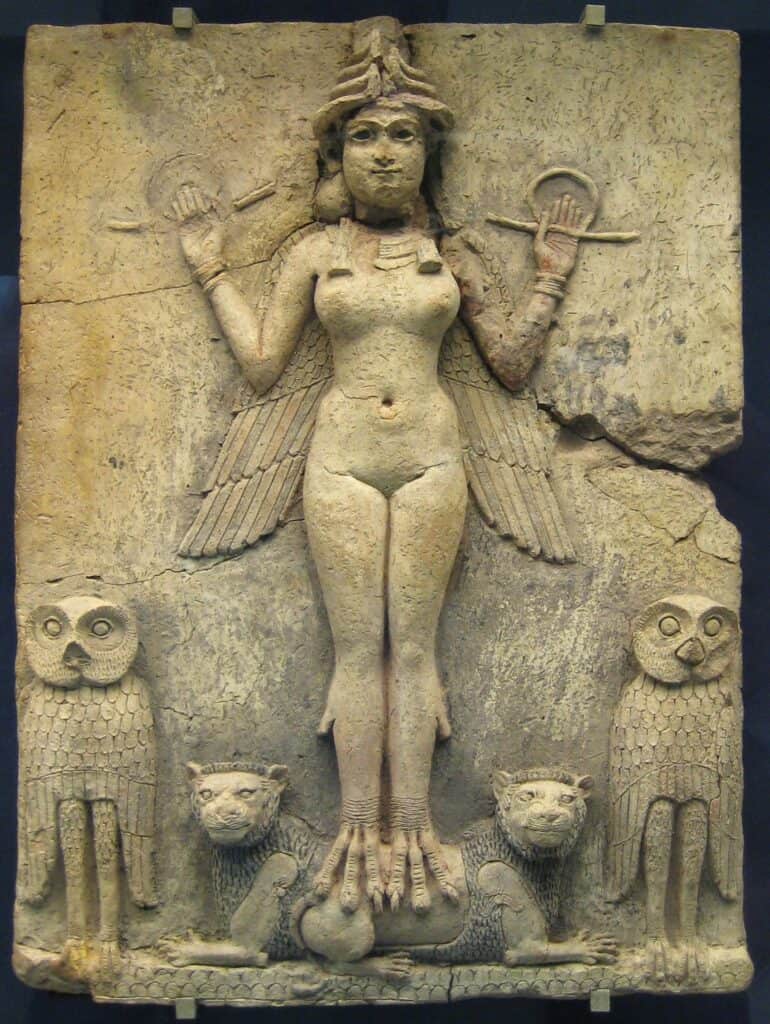By Ellen Komp
The theme of this year’s 35th annual Women’s History Month is “Women Providing Healing, Promoting Hope.” I can’t think of a more appropriate theme to celebrate the historical (some would say, herstorical) association between women and cannabis.
 GOING BACK TO THE ANCIENTS
GOING BACK TO THE ANCIENTS
The connection between women and herbal medicine, spiritual practices, and cannabis goes back thousands of years. My book “Tokin’ Women: A 4000-Year Herstory of Women and Marijuana” begins with the ancient Sumerian goddess Ishtar, also called the Queen of Heaven.
Ishtar was a compassionate, healing deity associated with the Akkadian herb qunnabu (cannabis), when distillation of plant essences into medicines was common in Sumeria. At least until the Semitic invasions circa 2600 BC, women were respected as healers in the Middle Eastern region, but after 1000 BC they were excluded from formal education. As the land of Sumer became a perpetual battlefield, Ishtar became the goddess of war and destiny, “and slowly, insidiously, there crept in more praises for her sexuality, and fewer for her healing nature,” writes Jeanne Actenberg in Woman as Healer.
In the bible, Ishtar or her mother Asherah are called Ashtoreth, the supreme goddess of Caanan and the female counterpart of the gods called Baal or Bel. In Jeremiah 44, women tell the prophet they will continue to secretly burn incense to the Queen of Heaven. In 2020, researchers tested resin found on an Judean altar from the 8th century and found cannabis, theorizing that it was used “to stimulate ecstasy.”
“Taking into account the matriarchal element of Semitic culture, one is led to believe that Asia Minor was the original point of expansion for both the society based on the Matriarchal circle and the mass use of hashish,” wrote Polish Anthropologist Sula Benet, who theorized in 1936 that the “kaneh bosm” or “fragrant cane” used in Moses’s holy anointing oil in the Bible was cannabis.
Trade routes of the time stretched to the Altai mountains of Siberia, where in 1993 the frozen remains of an elaborately tattooed “Ice Princess” were discovered buried along with a container of cannabis. She was apparently a high priestess of the Pazyryk people, who were closely related to the Scythians, the tribe that inhaled cannabis smoke ritually, as described by the Greek historian Herodotus in 440BCE.
In her book The Amazons: Lives & Legends of Warrior Women Across the Ancient World, Stanford Professor Adrienne Mayor presents new archeological and DNA evidence for the existence of the once-mythical Scythian Amazon Women and their use of cannabis. Mayor points out that burial mounds found in the Altai region housed both male and female warriors, along with weapons, hemp clothing, and “personal kits for smoking hemp.”
In 2014, a team of Russian scientists found evidence of breast cancer, a bone infection, and injuries consistent with a fall from a horse in the Siberian Ice Princess. “It is likely that for this sick woman, the regular inhalation of cannabis smoke was a necessity,” wrote the researchers.
Other recent discoveries include a Viking ship buried for 11 centuries with the remains of two women, along with a small leather pouch containing cannabis seeds. One or both of the Viking women, whose ages have been estimated at 50 and 70, may have been a Volva (a priestess or seeress).
As Barbara Ehrenreich writes in her book, Witches, Midwives and Nurses, the wise women of old used many plant-derived herbal remedies, such as ergot and belladonna, to assist in childbirth, and archeological evidence points to cannabis also being used this way. The witch/healer’s methods were “a great threat” to the Church, writes Ehrenreich, “for the witch was an empiricist: she relied on her senses rather than faith or doctrine.” We know what happened to a lot of those women.
MODERN WOMEN AND CANNABIS
In more modern times, too, women have been involved with using and promoting the healing properties of cannabis.
The Dark Ages began to enlighten up in the 11th century when Hildegarde von Bingen, a prominent German abbess, mentions using hemp as an herbal medication in her writing. We don’t know for sure that Queen Victoria used cannabis medicinally, only that one of her doctors wrote a glowing account of its use, including for menstrual cramps. Victoria’s contemporary Mary Todd Lincoln, a hemp farmer’s daughter, was treated at a sanitarium where hashish—then available in pharmacies—was prescribed.
Melissa Etheridge took a brave stand in 2005 when she said publicly that she smoked marijuana to help with the side effects of chemotherapy during her treatment for breast cancer. She has since some “out” for further understanding and legalization of the plant, even starting a company that makes cannabis-infused wines.
Whoopi Goldberg has been another advocate, co-founding a company that focused on cannabis remedies for women, and working with New York legislator Linda B. Rosenthal on a bill to permit the use of cannabis for menstrual cramps in New York.
Goldberg and many others have come out in support of Sha’Carri Richardson, who arguably was using cannabis medicinally when she smoked it to cope with learning about the death of her mother from a reporter just before running in (and winning) last year’s Olympic trial in the women’s 100-meter race. Richardson’s ban from competing in the Tokyo Olympics shows us that we must keep fighting for our medicine or inebriant of choice, and our ancient herstory inspires us to never lose hope.
Ellen Komp is the Deputy Director of California NORML, the state chapter of the National Organization for the Reform of Marijuana Laws. She blogs at https://tokinwoman.blogspot.com/.



